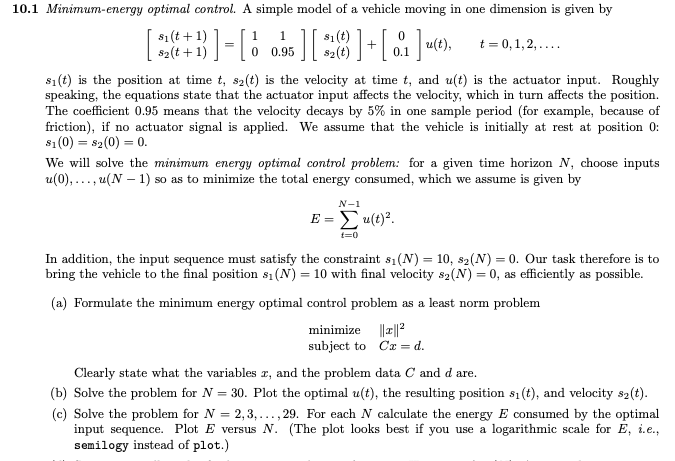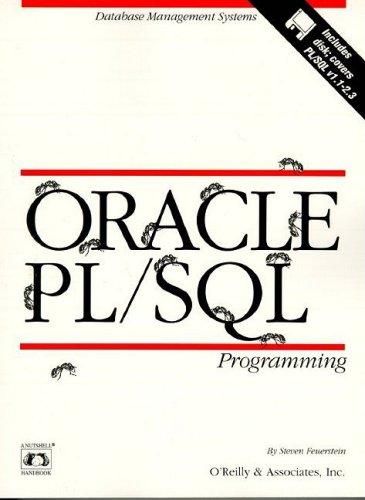Answered step by step
Verified Expert Solution
Question
1 Approved Answer
Please post Matlab code too. 10.1 Minimum-energy optimal control. A simple model of a vehicle moving in one dimension is given by [ m}} ]

Please post Matlab code too.
10.1 Minimum-energy optimal control. A simple model of a vehicle moving in one dimension is given by [ m}} ] - [6 0.95 ] [ 2%] + [ al ]uce), $2(t+1) Sz(t) t=0,1,2,.... si(t) is the position at time t, sz(t) is the velocity at time t, and ult) is the actuator input. Roughly speaking, the equations state that the actuator input affects the velocity, which in turn affects the position. The coefficient 0.95 means that the velocity decays by 5% in one sample period (for example, because of friction), if no actuator signal is applied. We assume that the vehicle is initially at rest at position 0: $1(0) = 82(0) = 0. We will solve the minimum energy optimal control problem: for a given time horizon N, choose inputs u(0), ..., (N 1) so as to minimize the total energy consumed, which we assume is given by N-1 = u(t)2. t=0 In addition, the input sequence must satisfy the constraint 51(N) = 10, $2(N) = 0. Our task therefore is to bring the vehicle to the final position s(N) = 10 with final velocity s2(N) = 0, as efficiently as possible. (a) Formulate the minimum energy optimal control problem as a least norm problem minimize || 2:12 subject to Cx = d. Clearly state what the variables r, and the problem data C and d are. (b) Solve the problem for N = 30. Plot the optimal u(t), the resulting position s(t), and velocity sz(t). (c) Solve the problem for N = 2, 3,..., 29. For each N calculate the energy E consumed by the optimal input sequence. Plot E versus N. (The plot looks best if you use a logarithmic scale for E, i.e., semilogy instead of plot.) 10.1 Minimum-energy optimal control. A simple model of a vehicle moving in one dimension is given by [ m}} ] - [6 0.95 ] [ 2%] + [ al ]uce), $2(t+1) Sz(t) t=0,1,2,.... si(t) is the position at time t, sz(t) is the velocity at time t, and ult) is the actuator input. Roughly speaking, the equations state that the actuator input affects the velocity, which in turn affects the position. The coefficient 0.95 means that the velocity decays by 5% in one sample period (for example, because of friction), if no actuator signal is applied. We assume that the vehicle is initially at rest at position 0: $1(0) = 82(0) = 0. We will solve the minimum energy optimal control problem: for a given time horizon N, choose inputs u(0), ..., (N 1) so as to minimize the total energy consumed, which we assume is given by N-1 = u(t)2. t=0 In addition, the input sequence must satisfy the constraint 51(N) = 10, $2(N) = 0. Our task therefore is to bring the vehicle to the final position s(N) = 10 with final velocity s2(N) = 0, as efficiently as possible. (a) Formulate the minimum energy optimal control problem as a least norm problem minimize || 2:12 subject to Cx = d. Clearly state what the variables r, and the problem data C and d are. (b) Solve the problem for N = 30. Plot the optimal u(t), the resulting position s(t), and velocity sz(t). (c) Solve the problem for N = 2, 3,..., 29. For each N calculate the energy E consumed by the optimal input sequence. Plot E versus N. (The plot looks best if you use a logarithmic scale for E, i.e., semilogy instead of plot.)Step by Step Solution
There are 3 Steps involved in it
Step: 1

Get Instant Access to Expert-Tailored Solutions
See step-by-step solutions with expert insights and AI powered tools for academic success
Step: 2

Step: 3

Ace Your Homework with AI
Get the answers you need in no time with our AI-driven, step-by-step assistance
Get Started


